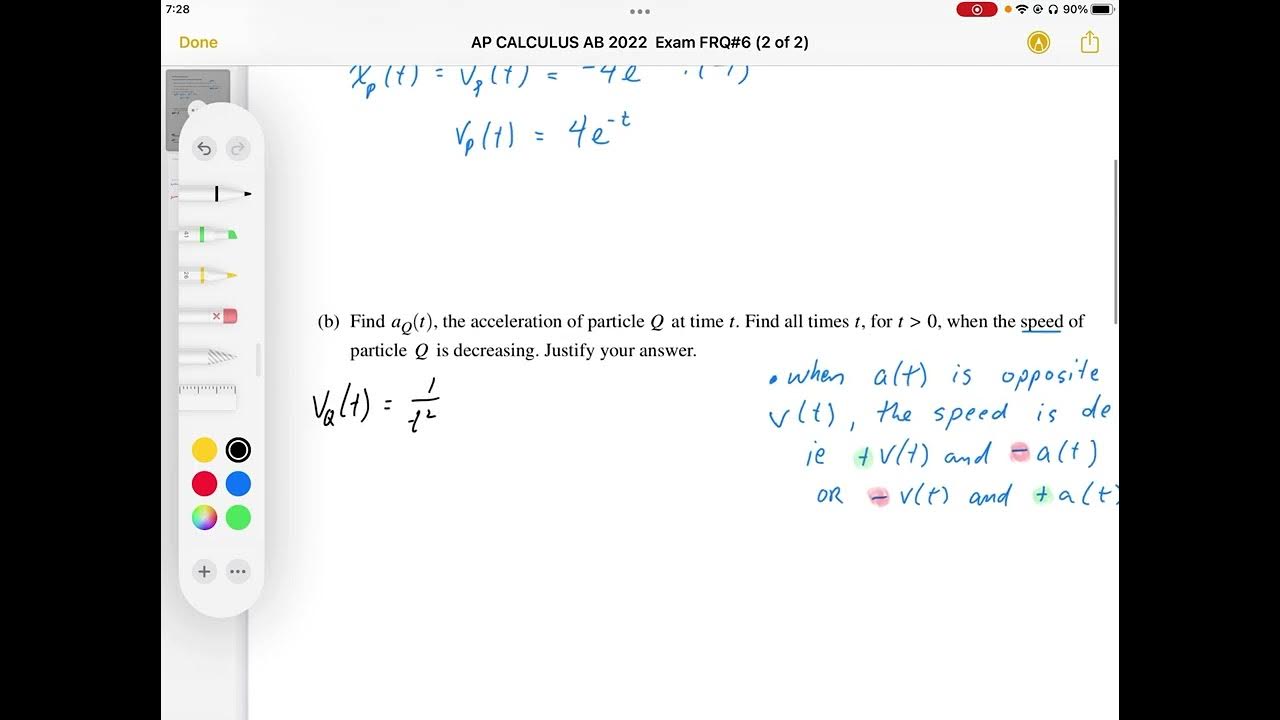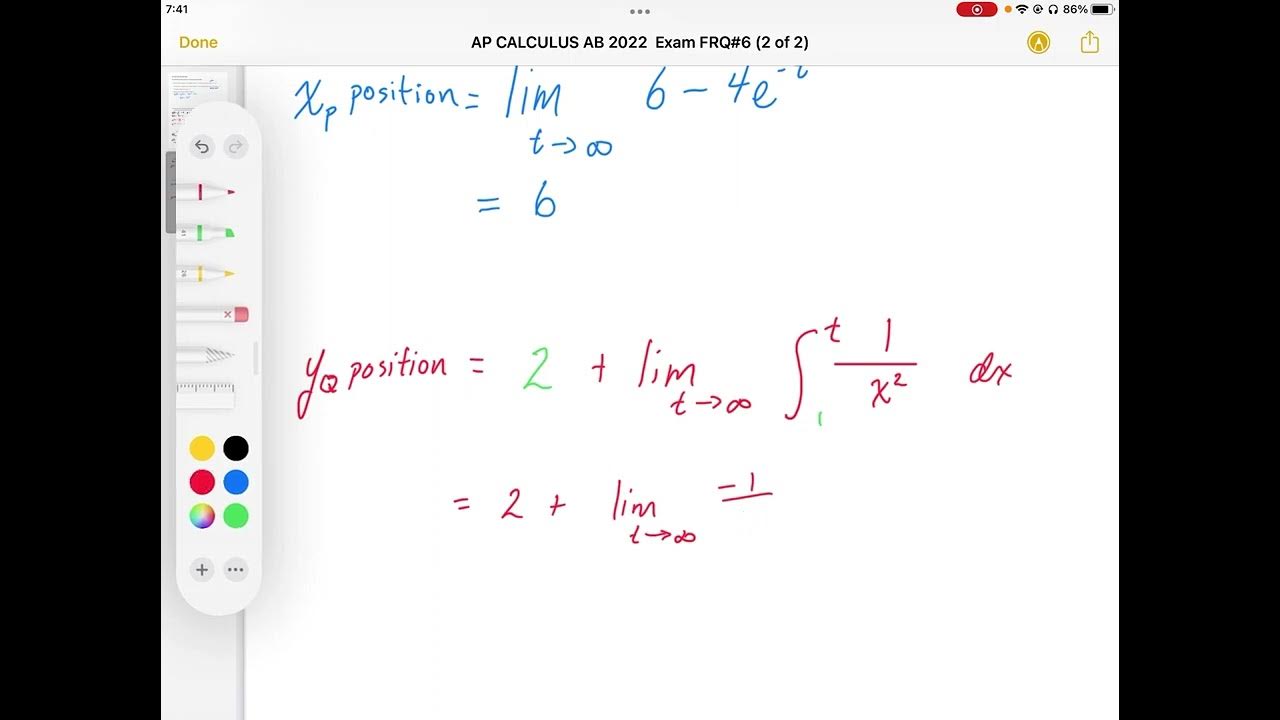2022 AP Calculus AB Free Response #6
TLDRThis transcript details a physics problem involving two particles, P and Q, moving along the x-axis. Particle P's position is given by an exponential function for t > 0, while Particle Q's velocity is described by a power function of time. The problem involves finding the velocity of Particle P, the acceleration of Particle Q, and determining when Particle Q's speed is decreasing. The solution involves differentiation and integration of the given functions. It's shown that Particle Q always slows down for t > 0, and its position function is derived using antiderivatives. The value of a constant 'c' is found using a given condition at t=1. As t approaches infinity, the positions of both particles are determined, with Particle P approaching a position of 6 units and Particle Q approaching 3 units from the origin. The summary concludes with a verification of the position equations for both particles.
Takeaways
- 📐 **Derivative of Position for Particle P**: The velocity of particle P (v_p) is found by taking the derivative of its position function, resulting in -4e^(-t).
- ⏱️ **Velocity of Particle Q**: The velocity function for particle Q (v_q) is given by t^(-2), which is always positive for t > 0.
- 📉 **Acceleration of Particle Q**: The acceleration (a_q) for particle Q is the derivative of its velocity, resulting in -2/t^3, indicating a constant deceleration for t > 0.
- 🔍 **Deceleration of Particle Q**: The speed of particle Q is decreasing when the velocity and acceleration have different signs, which is always the case for t > 0.
- 🧮 **Position Function for Particle Q**: The position function y_q is the antiderivative of v_q, leading to y_q = -1/t + c, where c is determined to be 3 using the initial condition y(1) = 2.
- ∞ **Limit of Particle Q's Position**: As time t approaches infinity, the position y_q approaches 3, indicating particle Q will be 3 units away from the origin.
- 📉 **Limit of Particle P's Position**: The position x_p of particle P approaches 6 as time t goes to infinity, as e^(-t) approaches 0.
- 🔢 **Final Positions**: Particle P will be 6 units and particle Q will be 3 units from the origin as t approaches infinity.
- 🔄 **Particle P's Movement**: Particle P moves along the x-axis with a position function that involves an exponential term, indicating a decaying movement towards a maximum position.
- 🚀 **Particle Q's Movement**: Particle Q's velocity is inversely proportional to the square of time, suggesting a specific type of motion where the particle slows down as time increases.
- 🧳 **Initial Conditions**: The initial conditions for particle Q's position at t=1 are used to solve for the constant c in the position function.
- 📝 **Double-Checking**: The speaker emphasizes the importance of double-checking the calculations and the wording to ensure accuracy in the analysis.
Q & A
What is the position function of particle p for time t greater than zero?
-The position function of particle p is given by the expression 6 - 4e^(-t).
How is the velocity of particle p, v_p, defined in terms of its position?
-The velocity of particle p, v_p, is defined as the derivative of its position function with respect to time, which results in v_p = -4e^(-t).
What is the velocity function of particle q for time t greater than zero?
-The velocity function of particle q is given by the expression v_q = t^(-2).
How do you find the acceleration of particle q, a_q, at time t?
-The acceleration of particle q, a_q, is found by taking the derivative of the velocity function, resulting in a_q = -2t^(-3).
When is the speed of particle q decreasing?
-The speed of particle q is decreasing for all times t greater than zero, as the velocity v_q is always positive and the acceleration a_q is always negative, indicating that the speed is always decreasing.
How do you determine the position function y_q of particle q as a function of time?
-The position function y_q is found by integrating the velocity function v_q, which gives y_q = -1/t + c, where c is a constant determined by the initial conditions.
What is the value of the constant c in the position function of particle q?
-The value of the constant c is determined by the condition that at time t = 1, the position y is 2. This gives c = 3, so the position function is y_q = -1/t + 3.
As time t approaches infinity, how does the position y_q of particle q behave?
-As t approaches infinity, the position y_q approaches the constant value of 3, because the term -1/t goes to zero.
What is the position of particle p as time t approaches infinity?
-As t approaches infinity, the position x_p of particle p approaches the constant value of 6, because the term -4e^(-t) goes to zero.
Which particle, p or q, will be farther from the origin as time t goes to infinity?
-Particle p will be farther from the origin as t goes to infinity, as its position approaches 6 units, compared to particle q which approaches 3 units.
What is the significance of the signs of velocity and acceleration in determining whether a particle is speeding up or slowing down?
-If the velocity and acceleration of a particle have opposite signs, the particle is slowing down. If they have the same sign, the particle is speeding up. In the case of particle q, since the velocity is always positive and acceleration is always negative for t > 0, it is always slowing down.
How can you verify the position equations for particle p and q?
-You can verify the position equations by taking the limit as t approaches infinity for both equations. For particle p, the limit of (6 - 4e^(-t)) as t approaches infinity is 6. For particle q, the limit of (-1/t + 3) as t approaches infinity is 3.
Outlines
🔍 Calculating Velocity and Acceleration of Particles
The first paragraph discusses the calculation of the velocity (v_p) and acceleration (a_q) of two particles, p and q, moving along the x-axis. The position of particle p is given by an exponential function for t > 0, and its velocity is found by taking the derivative of this position function, resulting in 4e^(-t). For particle q, the velocity function is given by 1/t^2 for t > 0, leading to an acceleration function of -2/t^3 after differentiation. The analysis continues with determining when the speed of the particle is decreasing, which is when the velocity and acceleration have different signs. Since the velocity of particle q is always positive and the acceleration is always negative for t > 0, it is concluded that the speed is always decreasing. The position of particle q is then found by integrating its velocity function, resulting in y_q = -1/t + c, where the integration constant c is determined to be 3 using the condition y_q = 2 at t = 1. Finally, the paragraph explores which particle will be farther from the origin as t approaches infinity, concluding that particle p will be 6 units away and particle q will be 3 units away, based on the limits of their respective position functions.
📝 Reviewing Position Equations for Particles
The second paragraph is a brief review of the position equations derived for the two particles from the first paragraph. It confirms that the position equations for both particles are straightforward and there are no complexities or ambiguities in the wording or the mathematical expressions provided. The speaker reassures themselves that the information is read and understood correctly, indicating a moment of reflection or verification before proceeding.
Mindmap
Keywords
💡particle p
💡position
💡velocity
💡derivative
💡acceleration
💡speed
💡antiderivative
💡power rule
💡constant of integration
💡limit
💡exponential function
Highlights
Particle P moves along the x-axis with its position given by an exponential function for t > 0.
Particle Q's velocity is given by a function of time t for t > 0.
The velocity of Particle P (v_p) is found by taking the derivative of its position function.
The acceleration of Particle Q (a_q) is determined by differentiating its velocity function, resulting in a negative value for t > 0.
The speed of Particle Q is decreasing for all times t > 0 as the velocity and acceleration are always of opposite signs.
The position of Particle Q (y_q) is found by integrating its velocity function, resulting in a function involving 1/t.
The constant of integration c is determined by using the initial condition y_q = 2 at t = 1, giving c = 3.
As t approaches infinity, the position of Particle Q (y_q) approaches 3 units from the origin.
For Particle P, as t approaches infinity, its position (x_p) approaches 6 units from the origin.
The position equations for Particles P and Q are verified to ensure they are correctly derived.
The transcript demonstrates the process of finding position, velocity, and acceleration for particles moving along an axis using calculus.
The use of derivatives and integrals is emphasized in determining the motion of the particles over time.
Initial conditions are crucial in finding the constant of integration for the position function.
The behavior of the particles' speed and acceleration over time is analyzed to understand their motion.
The limits of the position functions as time approaches infinity are calculated to determine the particles' final positions.
The transcript provides a step-by-step walkthrough of solving a physics problem involving particle motion using calculus.
The importance of verifying the derived equations and checking for any inconsistencies is highlighted.
The problem tests the understanding of concepts like position, velocity, acceleration, derivatives, and integrals in the context of particle motion.
Transcripts
5.0 / 5 (0 votes)
Thanks for rating:





